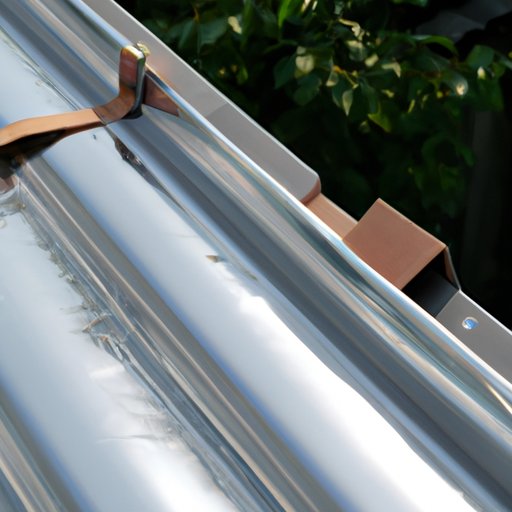Introduction
If you’re thinking of installing metal roofing for a DIY project, you’ve come to the right place. This step-by-step guide will walk you through the process of installing metal roofing so that you can achieve a successful and long-lasting result.
In this article, we’ll provide a step-by-step installation guide, a comprehensive list of tools and equipment needed, insider tips and tricks, safety guidelines to follow, common mistakes to avoid, and the importance of proper maintenance. Let’s get started!
Step-by-Step Guide
Measuring the Roof
Before beginning the installation process, you’ll need to measure your roof to know how much metal roofing material you will need. Measure the length and width of each section of the roof and multiply them to determine the square footage. It’s important to measure accurately as this will impact the number of panels you need to buy.
Preparing the Roof for Installation
Start by removing the old shingles from your roof, and check that the decking is in good condition. If it isn’t, replace any damaged or rotted wood decking to ensure a solid and stable base for your metal roofing. Check that the roof has proper ventilation to avoid any moisture problems.
Laying the Underlayment
Lay a high-quality underlayment or membrane before starting to add the panels. Most metal roofing systems include an underlayment also known as a roof deck protection. Standard roofing underlayment should be at least 30lb felt paper. The underlayment serves as a secondary protective layer, adding extra weather protection and preventing any moisture from getting into the home.
Installing the Metal Panels
Place the metal panels perpendicular to the ridge of the roof and let one inch to overlap the existing edges. Secure the panels with screws or nails; make sure that you install the fasteners in the flat area just above the panel’s ribs or halfway down the overlapping panel. Avoid overdriving the fasteners to prevent any damage to the metal panels.
Fitting Panels Around Obstacles
If you have an obstacle like a chimney or skylight to fit the metal panels around them. Start by measuring and cutting the needed pieces. A helpful tip is to use the right cutting tools when fitting around obstacles to ensure a smooth finish. After, fasten the pieces around the obstacle and check the final result.
Installing End Caps and Trim
Finish the installation process by installing the end caps and trim. Typically, these are a part of the metal roofing system. Ensure that you use end caps and trims that are compatible with your metal roofing panels.
Tools and Equipment Checklist
Here is a comprehensive list of all the necessary tools and equipment you will need for metal roofing installation:
- Tape Measure
- Chalk Line
- Tin Snips or Circular Saw
- Screws or Nails
- Safety Glasses
- Gloves
- Ladder with stabilizer
Video Tutorial
We’ve found a fantastic video tutorial that demonstrates the installation process in an easy-to-follow way. Click here to access the video. Watching the video before you start installing metal roofing can give you a better understanding of the process, and make you more confident.
Tips and Tricks
Here are some insider tips and tricks to make the installation process more efficient and effective:
- Start with the correct panel, such as ridge cap or edge flashes first.
- Use a screw guide to locate the right position for the screws.
- Pre-drill holes in metal panels to avoid any damage to the metal.
- Use a fine-grit sandpaper to smooth out any sharp edges on the metal panels.
Safety Guidelines
During the metal roofing installation process, it’s essential to take all safety precautions, including:
- Avoid working on the roof during wet or windy weather conditions.
- Wear appropriate clothing and footwear, to provide stability when working at heights.
- Always use proper ladder safety techniques and consider using a stabilizer.
- Always have someone nearby monitoring you for safety.
Common Mistakes to Avoid
Here are some common mistakes that people make when installing metal roofing that you can avoid:
- Not starting with a straight line can lead to an overall uneven finish.
- Over- or under-tightening fasteners can cause damage to the panels.
- Using the wrong type of screws or nails can lead to rusting and corrosion.
Maintenance and Care
With proper maintenance and care, metal roofing can last for many years. Here are some tips to keep your metal roofing looking great:
- Remove debris regularly from your roof with a leaf blower or broom.
- Inspect the roofing panels for damage and repair them promptly.
- Inspect your roof routinely to ensure no damage or corrosion has occurred.
Conclusion
Installing metal roofing may seem overwhelming at first, but with this step-by-step guide, you can do it with ease. Keep in mind the tips and tricks, safety guidelines, and common mistakes to avoid to achieve the best possible finish. With proper maintenance and care, you can have durable and long-lasting metal roofing for years to come.
